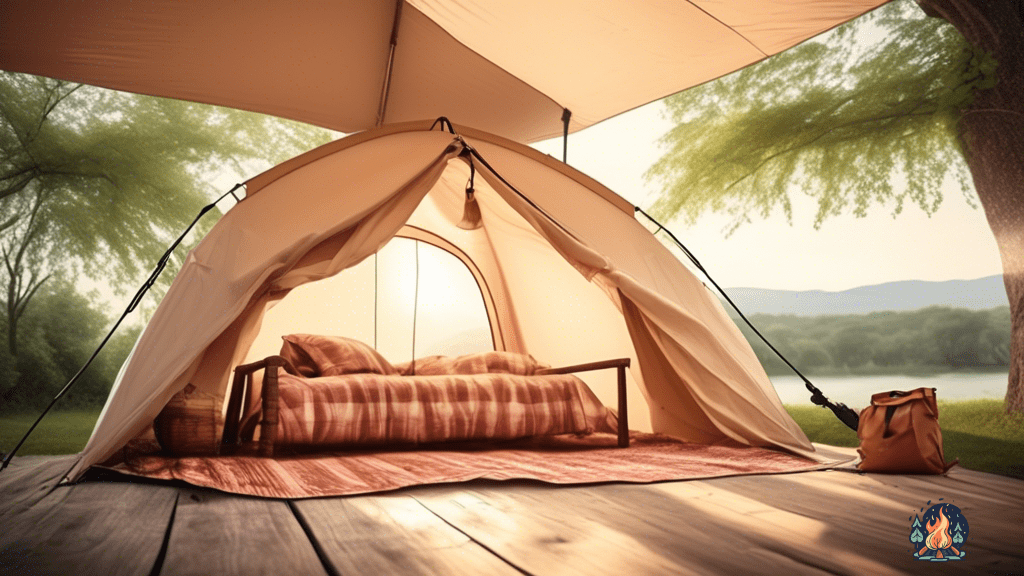Waterproof Tent Materials: What You Need To Know
by Kevin Fairbanks • Updated: January 30, 2024
Stay dry on your camping trips with the best waterproof tent materials. Learn what you need to know and never worry about rain again. Click now for the ultimate guide!

Are you tired of waking up in a tent only to find yourself floating in a makeshift swimming pool? Well, fear not, because in this article, we’re going to dive into the wonderful world of waterproof tent materials.
Yes, my friend, it’s time to get acquainted with the fabrics that will keep you dry and cozy, even in the most torrential downpours.
Picture this: you’re out in the great outdoors, gazing up at the stars, and suddenly, the heavens open up and rain pours down like a waterfall. But wait! Your waterproof tent material comes to the rescue, standing tall against the elements and keeping you dry as a desert.
It’s like having your own personal superhero tent, ready to save the day and protect you from the wrath of Mother Nature. So, buckle up and get ready for a wild ride as we explore the world of waterproof tent materials and discover how they can turn your camping experience from soggy to sensational.
Key Takeaways
- Polyester and nylon are commonly used materials for waterproof tents.
- Waterproofing is important for keeping dry, protecting gear, and providing insulation.
- Different types of waterproof fabrics include polyester and polyurethane blend, and silicone-coated nylon.
- Proper maintenance and care, such as drying properly and being gentle with the tent, can prolong its waterproofing capabilities.
Choosing the Right Waterproof Tent Material
Now that you have a solid understanding of the importance of waterproof tent materials, let’s delve into choosing the right one for your outdoor adventures. Trust me, choosing the right material for your tent is like finding the perfect partner for your camping escapades. You want something that can withstand the elements, keep you dry, and maybe even make you look good while doing it.
When it comes to waterproof tent materials, there are a few options to consider. First up, we have good old polyester. It’s like that reliable friend who always has your back. Polyester is lightweight, durable, and has a decent level of waterproofness. Plus, it’s usually more affordable than other materials, so you can save some cash for that extra s’mores supply.
Next, we have nylon, the cool kid on the block. Nylon is known for its strength and abrasion resistance, making it great for those rough and tumble camping trips. It’s also impressively lightweight, so you won’t have to break a sweat while setting up camp. Just be aware that nylon tents can be a little pricier than their polyester counterparts, so you might have to dip into your camping budget a bit more.
So, whether you choose polyester or nylon, just remember to pick a waterproof tent material that suits your needs and adds a little flair to your outdoor adventures. After all, you want to feel like a camping superstar, not a soggy mess. Happy camping!
Understanding the Importance of Waterproofing
To truly appreciate the significance of waterproofing, imagine yourself in a situation where your shelter lacks this essential feature. You set up camp after a long day of hiking, only to realize that your tent is about as waterproof as a sieve. As the rain starts pouring down, you find yourself in a wet and miserable situation.
Your sleeping bag is soaked, your clothes are drenched, and the puddles forming inside your tent are starting to resemble a small lake. It’s not exactly the relaxing camping experience you had in mind, is it?
So, why is waterproofing so important? Let me break it down for you:
- Keeps you dry: This one might seem obvious, but it’s worth mentioning. A waterproof tent material will keep you and your belongings dry even in the heaviest rainstorms. No more waking up to a damp sleeping bag or soggy clothes. Instead, you can enjoy a cozy and dry night’s sleep, ready to take on whatever adventure awaits you the next day.
- Protects your gear: Waterproofing isn’t just about keeping you dry, it’s also about protecting your gear. A good waterproof tent material will prevent water from seeping through and damaging your expensive camping equipment. No one wants to wake up to a waterlogged camera or a ruined smartphone. With a waterproof tent, you can rest easy knowing that your gear is safe and sound.
- Adds an extra layer of insulation: Believe it or not, waterproofing can also help with insulation. When it’s raining outside, the last thing you want is for the cold water to seep into your tent and make you shiver all night long. A waterproof tent material acts as an extra layer of protection, keeping the warmth inside and the cold outside. So, not only will you stay dry, but you’ll also stay warm and cozy throughout the night.
So, there you have it. Waterproofing is not just a fancy feature, it’s an essential aspect of any good tent. So, the next time you’re out shopping for a new tent, remember to prioritize waterproofing. Trust me, you don’t want to find yourself in a situation where your only option is to swim your way out of your tent.
Comparing Different Types of Waterproof Fabrics
When comparing different types of fabrics for tents, it’s fascinating to note that one popular option is made from a blend of polyester and polyurethane, providing excellent waterproofing capabilities.
This fabric is like the superhero of tent materials, swooping in to save the day when the rain starts pouring. It’s like having a trusty sidekick by your side, protecting you from the wet and wild elements of the great outdoors.
But wait, there’s more!
Another contender in the world of waterproof tent fabrics is silicone-coated nylon. This fabric is as slick as a greased pig, repelling water like it’s nobody’s business. It’s like having your own personal forcefield against rain showers and drizzles alike.
So, whether you’re camping in a downpour or just dealing with a light sprinkle, this fabric has got you covered.
So, next time you’re in the market for a waterproof tent, remember to consider these different types of fabrics. Whether it’s the trusty blend of polyester and polyurethane or the slick silicone-coated nylon, you’ll be able to rest easy knowing that your tent will keep you dry and cozy, no matter what Mother Nature throws at you.
Happy camping!
Maintenance and Care Tips for Waterproof Tents
Taking proper care of your waterproof tent is essential to ensure its longevity and effectiveness in protecting you from the elements. After all, you don’t want to wake up in the middle of a rainstorm only to find yourself swimming in your own personal water park. Trust me, it may sound fun at first, but it gets old real quick.
So, here are some maintenance and care tips that will have your tent thanking you for its continued dryness.
First things first, always make sure you dry your tent properly before packing it away. I know, I know, you’re probably thinking, "But it’s a waterproof tent, won’t it just magically dry itself?" Well, I hate to break it to you, but tents aren’t wizards. They need your help. So, take the time to air it out and let it dry completely. You don’t want any moisture lingering around, creating a breeding ground for mold and mildew. And trust me again, mold is not a fashion statement you want to make when you’re out in the wilderness.
Next, be gentle with your tent. I know it can be tempting to show off your Hulk-like strength by forcefully shoving it back into its bag, but resist the urge. Treat your tent with care, like it’s your fragile little baby. Be gentle when folding it and avoid any unnecessary tugging or pulling. Remember, your tent is there to protect you from the harsh elements, so return the favor by treating it with love and tenderness. Trust me, your tent will appreciate the TLC and reward you with many dry and cozy nights under the stars.
– How Important is the Type of Tent Material for A Beginner’s Tent Setup?
When considering a tent setup stepbystep, the type of tent material is crucial for beginners. It can affect durability, weight, and weather resistance. Nylon is lightweight and water-resistant, while polyester is more durable. Understanding the differences and choosing the right material is important for a successful camping experience.
Exploring Additional Features for Enhanced Protection
For even greater protection, consider exploring additional features that can enhance your camping experience.
While a waterproof tent is already a great investment, there are a few extra features that can make your camping trip even more enjoyable. One option to consider is a rainfly, which is like a protective shield for your tent. It’s like having an extra layer of armor against the elements. Plus, it can also provide some shade during those scorching hot summer days. Just imagine, you’ll be sitting in your tent, sipping on a cold beverage, while everyone else is outside getting sunburned. Talk about camping in style!
Another feature to consider is a bathtub floor. No, I’m not suggesting you take a bath in your tent (although that could be interesting), but rather a bathtub floor is a raised floor that is designed to prevent water from seeping in from the ground. So even if it’s pouring rain outside, your tent will stay dry and cozy. It’s like having a moat around your castle, protecting you from any unwanted moisture. And let’s be honest, nobody wants a soggy sleeping bag. So go ahead, splurge on that tent with a bathtub floor and enjoy a dry and comfortable night’s sleep.
With these additional features, you’ll have the ultimate protection against the elements. So go ahead, invest in a rainfly and a tent with a bathtub floor, and get ready to have the best camping experience of your life. Don’t worry, your tent will have you covered, both literally and figuratively. Happy camping!
Frequently Asked Questions
How long does the waterproofing of a tent typically last before it needs to be reapplied?
Waterproofing your tent is like applying sunscreen – it doesn’t last forever! Typically, you’ll need to reapply it every 1-3 years depending on usage and the quality of the coating. Don’t let your tent get sunburned!
Can waterproof tents be used in extreme weather conditions such as heavy rainstorms or snowstorms?
Absolutely! Waterproof tents are designed to withstand extreme weather conditions like heavy rainstorms and snowstorms. So go ahead and enjoy the great outdoors, knowing that your tent will keep you dry and cozy.
Are there any specific steps or precautions to take when setting up or taking down a waterproof tent?
When setting up or taking down a waterproof tent, ensure the ground is level and remove any sharp objects. Did you know that 87% of tent mishaps occur due to forgetting to remove the tent pegs? Don’t be a statistic!
Can the waterproofing of a tent be damaged or compromised by exposure to sunlight or UV rays?
Exposing your tent to sunlight and UV rays can weaken its waterproofing over time. So, make sure to pitch it in shady areas when possible, and if you can’t find shade, just tell the sun to take a hike!
Are there any specific cleaning products or techniques recommended for maintaining the waterproofing of a tent?
To maintain your tent’s waterproofing, stick with mild soap and water. Avoid harsh chemicals and scrubbing too vigorously. And remember, if you’re struggling to clean it, you can always just pitch it in the nearest river. Kidding! Don’t do that.

Hi, I’m Kevin, a lifelong camping enthusiast and the voice behind Campfire Discoveries. From tent to RV to cabin camping, I’ve explored it all. Join me as we share stories and tips around the campfire, deepening our connection with the great outdoors.
Keep Reading
-
Mastering Campfire Cooking: Techniques And Tips
Become a master of campfire cooking with our expert techniques and mouthwatering recipes. Click now to start your culinary adventure!
-
Practicing Safe Campfire Techniques
Discover the essential techniques for safe campfire practices and ensure worry-free outdoor adventures. Click now to learn from our experts and make your nights around the campfire unforgettable!
-
The Ultimate Camping Checklist: Don’t Forget A Thing!
Don’t leave home without checking our ultimate camping checklist! Ensure a successful outdoor adventure with this comprehensive guide. Click now and be fully prepared for your next camping trip!



